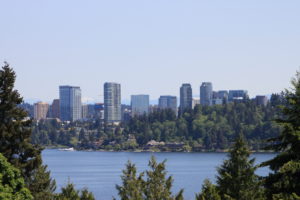Bellevue, WA

Bellevue, WA, a demographically diverse, mid-sized city near Seattle, is in an unique position to tackle issues in curbside management. Oversized “superblocks” in its downtown result in a smaller number of cross-streets and on-street parking spots compared to similar-sized cities. This makes traditional strategies for handling the city’s unprecedented job and population growth unfeasible.
In addition to handling traditional traffic pressure, a new wave of rideshare and freight delivery services have emerged in Bellevue, adding operational and safety challenges to the city’s transportation system. Further complicating matters, numerous large employers–such as Amazon, Microsoft, Expedia, and Facebook–offer commuter shuttle service for their employees. These services require dedicated curb space for loading and unloading passengers.
Why did Bellevue join the Smart Cities Collaborative? “We hope that participating as a Pilot City in the Smart Cities Collaborative will provide an opportunity to test new curbside techniques, share our expertise and learn from the nationwide network. Insights derived from the Collaborative would transfer seamlessly into the strategies and actions in our Curb Management Plan–a project commencing in 2020–ensuring continuity between the pilot and our long-term policies.”
Boston, MA

“America’s Walking City” is experiencing a new level of complexity on its streets as the city squeezes more curb uses into a finite streetscape. Between 2017-2018, the number of ride-hailing trips grew by 25 percent in Massachusetts; Boston added 90 new bike-share stations; and home parcel delivery continued its steady growth. This pressure to move more people and more goods on the city’s 850 mile network of streets is forcing the City of Boston to change the way it does business. “We are desperately in need of flexible, dynamic, and smarter curbs,” writes Matthew Warfield, a New Mobility Planner at the Boston Transportation Department.
Why did Boston join the Smart Cities Collaborative? “The Collaborative provides us with an opportunity to explore and experiment with new tools for managing our streets,” said Warfield. “We have been a leader in mobility innovation—from the first subway to the first city-centric autonomous vehicle testing program in the nation. But managing curb space in this new mobility ecosystem requires tough trade-offs of space and usage, colored by a mandate to combat climate change and increase equity in all our policies. In Boston we like to listen, we like to learn, and we like to lead. We see this as the perfect opportunity to flex that skill-set and be inspired by our peers.”
Minneapolis, MN

In Minneapolis—a city that recently ended single-family zoning—more varied transportation modes are competing for street and curb space than ever before. In addition to increased freight, rideshare, scooter, and bike activity, Minneapolis is experiencing increased pressures on parking as land use density increases. “Traditional single-occupancy vehicle users who have become accustomed to free or readily accessible curbside parking are upset by the changes needed to properly price and prioritize the curb for all the new modes and transit,” writes Danielle Elkins from the City of Minneapolis. “Driver behaviors are still not changing enough to account for this increased competition, creating significant tension.”
Why did Minneapolis join the Smart Cities Collaborative? With all of these changing priorities, Minneapolis is committed to reducing transportation emissions and ensuring access for people with disabilities. “The City would also like to leverage the Collaborative to assist with educating external stakeholders such as the general public and local asset managers,” said Elkins. “Through this communication, we hope to show our residents that we are being proactive in harnessing new technology to meet City goals, and not simply reacting to outside influences.”
